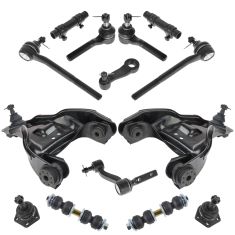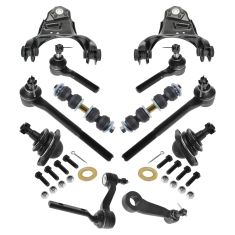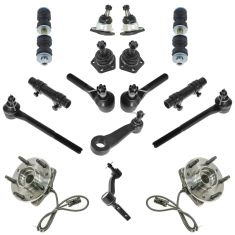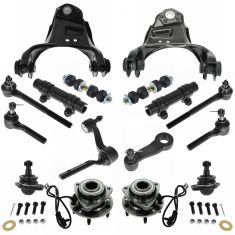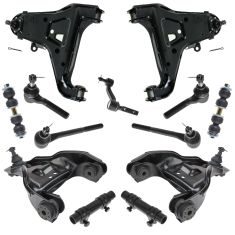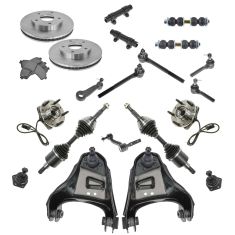1ASFK04077-Chevrolet GMC Olds Isuzu Front 13 Piece Steering & Suspension Kit TRQ PSA56421
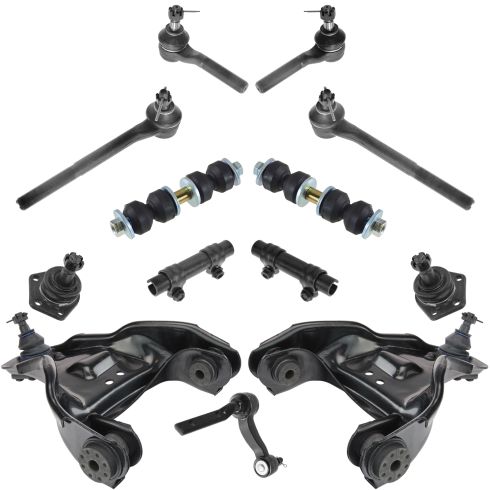
Replaces
1999 Chevrolet Blazer 4 Wheel Drive Front 13 Piece Steering & Suspension Kit TRQ PSA56421

You may also like
Product Reviews
Loading reviews
4.75/ 5.0
4
4 reviews
July 29, 2018
The parts came very quickly and packaged well! All pieces were in perfect shape! Very pleased!
Best site to get auto parts at a good price
October 20, 2018
I like the quality and good prices and I like the wide variety of parts selections I would recommended to my friends and family if they want to save some money on good quality parts front your site at a1auto
Spot on again
February 16, 2019
3rd time ordering front end package for 3rd vehicle and spot on again. Perfect fit for simple bolt on. And was delivered early.
March 7, 2022
Love it
Customer Q&A
Dose it come with upper and lower ball joints ?
November 5, 2021
10
Yes, the upper ball joints come pressed into the upper control arms. The lower ball joints are also included.
November 5, 2021
Andra M
Does this fit a 1999 chevy blazer 2 wheel drive?
November 12, 2021
10
This part will not fit your vehicle, but we may have a part that is listed to fit.
Please enter your vehicle's year make and model in the search bar at the top of the page. This will display parts guaranteed to fit your vehicle. Just be sure to verify all of the information shown in the Vehicle Fit tab before ordering.
November 12, 2021
Ricale A
Will this kit fit a 94 s10 4wd?
November 14, 2021
10
This part will not fit your vehicle, but we may have a part that is listed to fit.
Please enter your vehicle's year make and model in the search bar at the top of the page. This will display parts guaranteed to fit your vehicle. Just be sure to verify all of the information shown in the Vehicle Fit tab before ordering.
November 15, 2021
Ricale A
Does every one of these parts have grease fitting?
January 7, 2022
10
Yes, all of these parts will include the grease fittings.
January 7, 2022
Emma F
Will this kit fit a 2000 s10 with the zr2 package?
February 3, 2022
10
This kit is listed to fit all 2000 Chevrolet S10 Pickup models with 4 Wheel Drive.
February 3, 2022
Jessica D
Will this fit a 2000 Chevy blazer 4 wheel drive?
February 16, 2022
10
Yes, this part will fit your vehicle.
February 16, 2022
Kelly S
Does this come with hardware like the cam adjustment?
February 19, 2022
10
New hardware is not included with this item. You may be able to reuse your original hardware if it is in good condition.
February 19, 2022
Ricale A
Does this have the lower control arms with the ball joints?
October 21, 2022
10
The lower control arms are not included. The kit includes :
(2) Front Lower Ball Joints
(2) Front Upper Control Arms with Ball Joints
(2) Front Outer Tie Rods
(2) Front Sway Bar Links
(1) Idler Arm
(2) Front Inner Tie Rods
(2) Front Tie Rod Adjusting Sleeves
October 21, 2022
Andra M
Will this fit zr2?
May 8, 2023
10
Please provide your 17-digit VIN so we can verify fitment, thank you.
May 9, 2023
Jessica D
Chevrolet is a registered trademark of General Motors Company. 1A Auto is not affiliated with or sponsored by Chevrolet or General Motors Company.
See all trademarks.














